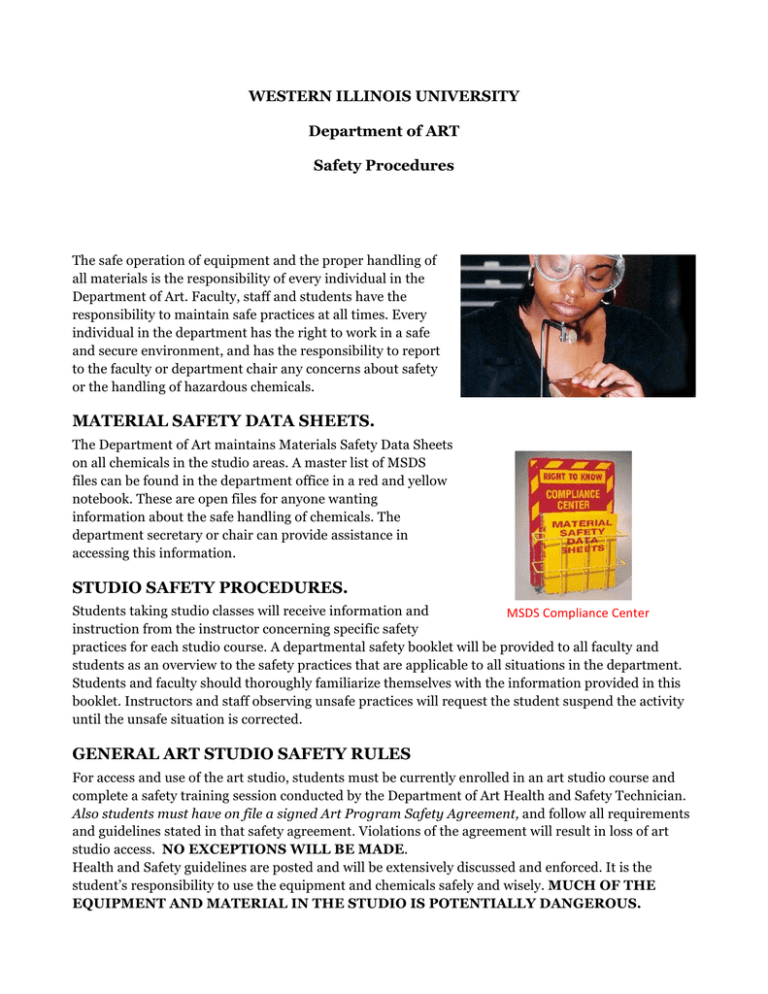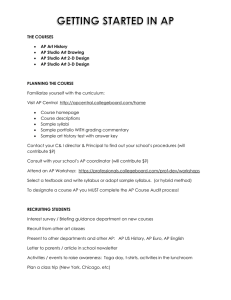Document 10822829
advertisement

WESTERN ILLINOIS UNIVERSITY Department of ART Safety Procedures The safe operation of equipment and the proper handling of all materials is the responsibility of every individual in the Department of Art. Faculty, staff and students have the responsibility to maintain safe practices at all times. Every individual in the department has the right to work in a safe and secure environment, and has the responsibility to report to the faculty or department chair any concerns about safety or the handling of hazardous chemicals. MATERIAL SAFETY DATA SHEETS. The Department of Art maintains Materials Safety Data Sheets on all chemicals in the studio areas. A master list of MSDS files can be found in the department office in a red and yellow notebook. These are open files for anyone wanting information about the safe handling of chemicals. The department secretary or chair can provide assistance in accessing this information. STUDIO SAFETY PROCEDURES. Students taking studio classes will receive information and MSDS Compliance Center instruction from the instructor concerning specific safety practices for each studio course. A departmental safety booklet will be provided to all faculty and students as an overview to the safety practices that are applicable to all situations in the department. Students and faculty should thoroughly familiarize themselves with the information provided in this booklet. Instructors and staff observing unsafe practices will request the student suspend the activity until the unsafe situation is corrected. GENERAL ART STUDIO SAFETY RULES For access and use of the art studio, students must be currently enrolled in an art studio course and complete a safety training session conducted by the Department of Art Health and Safety Technician. Also students must have on file a signed Art Program Safety Agreement, and follow all requirements and guidelines stated in that safety agreement. Violations of the agreement will result in loss of art studio access. NO EXCEPTIONS WILL BE MADE. Health and Safety guidelines are posted and will be extensively discussed and enforced. It is the student’s responsibility to use the equipment and chemicals safely and wisely. MUCH OF THE EQUIPMENT AND MATERIAL IN THE STUDIO IS POTENTIALLY DANGEROUS. Do not use any equipment or chemical if you have not been instructed in their use. Consult the professor. • Respirators, safety glasses, and gloves are recommended for use with all equipment. There are eyewash stations near the sinks. Basic first aid supplies are maintained in the studio. In Emergency situations dial 911, this will connect you with the Office of Public Safety. • Fire extinguishers are located in and around the studio. Please familiarize yourself with their location. • Any questions concerning the health requirements for or the health risks of a particular chemical or solvent may be found in the MSDS (Material Safety Data Sheet) book located in each studio. • NO FOOD OR DRINK IS ALLOWED IN THE STUDIOS AT ANY TIME. DEPARTMENT SAFETY RULES • • • • • • • • • • Familiarize yourself with the location of the eyewash and shower. Be sure all cans, containers, jars are tightly capped before you leave, even if you did not use them. Be familiar with the location of the fire extinguishers, fire alarm switches and emergency phone. Wear protective clothing, gloves, and safety glasses whenever using solvents or acid baths. Do not use saws or other power equipment while alone in the studio. No equipment may be used without training by faculty. Do not prop open studio doors after hours, or permit non-art major’s admittance to the studio. Do not climb ladders without assistance Do not eat the glue, paint, paper, or anything that is not meant to be consumed. Do not set yourself or anyone else on fire. In emergency situation, breathe deeply, and relax. EYE PROTECTION • Wear Safety Glasses when using power equipment, filing, sanding, grinding, and polishing an object or when handling dangerous chemicals such as acids. Glasses are available in the University Bookstore. An art major should purchase a pair of safety glasses as permanent equipment that will be used in numerous art courses. • When using welding equipment in metals and sculpture, the use of proper shaded eye protection is essential. The instructor in these classes will provide additional information and the necessary eye protection for welding. • In ceramics, no one should look directly into a high-firing kiln without shaded eye protection. This type of equipment is located in the kiln room. The instructor in ceramics will provide information concerning proper procedures. DUST MASKS AND VENTILATION • Students must use personal dust masks when sanding, filing or spraying any materials in the studio. Masks are available in the University Bookstore. Packages of masks can be purchased at local hardware and building supply stores. The use of aerosol cans should be kept at a minimum. Do not use spray paint or spray fixative inside the studio, unless using the paint booth with the fan on. • Always turn the exhaust fan on when working in the spray booth, the acid area, and the clean up booth. • All art studios have a ventilation system designed for the activities conducted in that area. Instructors teaching in the studio will provide information concerning the proper operation of the studio ventilation system. Students are required to operate the studio ventilation system when working in the studio where hazardous material may be generated. EAR PROTECTION • When operating any equipment that generates a loud noise, students are encouraged to wear earplugs or muffles. APPROPRIATE CLOTHING • Art studios have equipment and materials that can damage clothing. Students are encouraged to wear old clothing when working in studios. In areas which generate heat, such as the kiln room and sculpture studios, only cotton clothes should be worn. Avoid wearing synthetic clothes around heat sources such as kilns, foundries, grinders and welders. Synthetic clothes have a low flash point and will burn very quickly, causing severe burns. • Always wear leather or heavy canvas shoes that cover the entire foot in the studio areas where metals, glass, heat and acids are used. Flip-flops and bare feet are not allowed in any studio. • The wearing of jewelry in studio areas should be kept to a minimum since many studio activities can damage jewelry. Also, wearing items like rings, bracelets and necklaces can be a dangerous practice in activities such as working on the potter’s wheel. No loose fitting or flowing clothes should be worn in studios. Long hair should always be tied back. PERSONAL HYGIENE • Individuals working in studio situations where there is paint, inks, clays or chemicals should frequently wash their hands in order to avoid these materials entering the eyes, mouth or penetrating the skin. • It is especially important for one to thoroughly wash their hands at the end of a class and before leaving the studio. LIFTING OF HEAVY OBJECTS • In certain studio areas, heavy objects may need to be moved or lifted. To avoid back injuries, the department provides several dollies for this purpose. Stones, crates and bags of clay are just a few examples of objects that can be moved with these devices. • Whenever possible, students, staff and faculty members should use this equipment when handling large objects. • The instructors can provide access to this equipment. FIRE & GAS • Never have a cigarette lighter on your person while working around an area where there is a heat and/or fire source. • In the case of one's clothing catching on fire, remember to fall on the ground and roll over until the flames are extinguished. • In case of fire, evacuate the area immediately, close the door behind you, and call 911 and University police at extension 298-1949. • Never attempt to extinguish a minor fire with water. Each studio has a fire extinguisher that can be used to extinguish minor fires. In case of any fire, the evacuation and safety of people is the primary concern. • In the event that the smell of gas occurs in a studio, leave the area immediately. Do not turn on or off any lights or electrical devices in an area where gas is smelled. Once the area has been evacuated, notify the nearest instructor or staff person, or contact the University Police at extension 298-1949. IDENTIFICATION & DISPOSAL OF HAZARDOUS MATERIALS • Studios where hazardous materials are used have red disposal containers with yellow identification labels. • All hazardous liquids such as mineral spirits, lacquer thinner and turpentine must be disposed in these containers. • They MUST NEVER be poured down drains in the sinks. • All paper and fabrics contaminated with theses liquids must be placed in a designated red container. • Instructors in classes where these materials are used will provide specific information concerning the disposal of these chemicals. • Other materials such as clay, concrete, and plaster must never be washed down sinks and drains. Containers for recycling these materials are provided by the instructor teaching in the specific studio. LABELING OF ART MATERIALS • Please refer to the section on general safety labels for hazardous art materials located in the hard copy of the Department Safety Manual. • These manuals are available in the Department of Art office or in the art studios. The department office is located in on the third floor of Garwood Hall in room 32 Building. As part of their education, students should become familiar with a variety of the safety resources to be found on the web. Online Health and Safety in the Arts Library http://www.uic.edu/sph/glakes/harts/HARTS_library/index.htm Rhode Island School of Design Material Safety Data Sheet (MSDS) Information page http://intranet.risd.edu/departments/envirohealth/msds.asp?oID=Sculpture U.S. Environmental Protection Agency http://www.epa.gov/NE/assistance/univ/index.html




